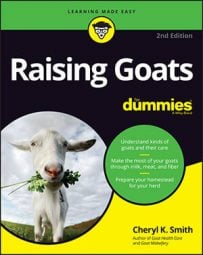You have several options for bedding:
-
Straw: Straw is easy to store because it comes in bales, and it’s inexpensive. Wheat straw is preferable to other straws because it's easier to muck out when used, it's less dusty, and the goats like to eat it when it’s fresh.
-
Wood shavings: Depending on where you live, wood shavings may be a better option. If you’re in a region with little rain, you won’t have a problem with storage, because you can even keep it outside.
-
Wood pellets: Wood pellets absorb urine and odors but are too hard and uncomfortable by themselves for goats to use as bedding. They also are expensive.
How frequently you need to muck your barn depends on the size of the area and how many goats you have. In the winter, if you live in a cold area, you can allow the muck to build up and add new bedding to the top. This provides extra heat for the goats from the composting bedding under the fresh layer. In the summer, you may be able to get away with mucking only once a month or so if your goats spend more time outdoors.
If you have a large area to be mucked and are lucky enough to have a tractor or similar equipment, you can use that. But if you have only a backyard or a small homestead, you’ll have to muck by hand. To muck a barn by hand, you need
-
Gloves
-
Muck boots or old shoes
-
A pitchfork
-
A wheelbarrow
Pace yourself. If you have a large area, start on one side and finish that first. You can do the other half the next day. It can help to have one or two people removing the used bedding and one running the wheelbarrow.
Use gloves to prevent blisters and muck boots to keep your shoes and clothes clean. If the used bedding is very deep, to save your back, take it off in layers with your pitchfork rather than trying to lift huge chunks.Move all of the used bedding to a single pile in a place where goats won’t be tempted to play on it. The pile may seem high at first, but with rain and time, it will shrink down to nice compost. Some people cover their muck pile with a tarp to aid in composting. Because goat manure doesn’t burn plants like chicken manure does, you can put it directly on the garden, if you choose.

